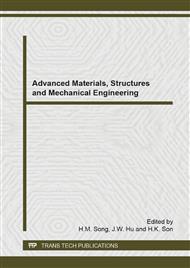p.436
p.440
p.445
p.451
p.455
p.461
p.466
p.470
p.476
New Nickel Based Superalloys Development by Vacuum Arc Melting Process Based on Aluminum Addition of GTD-111
Abstract:
This research objective is to study the microstructural modification by Al additions in cast nickel base superalloy, GTD-111 by means of vacuum arc melting process. The Al additions to the alloy were 1, 2 and 3% by weight. After that, all casted specimens were performed with different reheat treatment conditions, which consist of solutioning temperatures of 1125°C, 1145°C, 1165°C, 1185°C and 1205°C, respectively, for 6 hours following with precipitation aging at 845°C for 24 hours. After all reheat treatments, the microstructures were investigated and analyzed by SEM. From all obtained results, it was founded that the specimens with Al additions for 1-2%wt. following with reheat treatment show the decrease in size of γ’ precipitated particles when increasing solutioning temperatures. 3%wt. of Al addition was too high content resulting in already improper microstructural characteristics. However all obtained data of area fractions of precipitate phase were almost the same. Effect of Al addition and solutioning temperature did not provide any significant effect in this case. The mechanical property behavior: hardness was investigated by using Vickers hardness tester. It was found that the hardness all was very similar and increased with higher solutioning temperatures.
Info:
Periodical:
Pages:
455-460
Citation:
Online since:
September 2014
Price:
Сopyright:
© 2014 Trans Tech Publications Ltd. All Rights Reserved
Share:
Citation:


